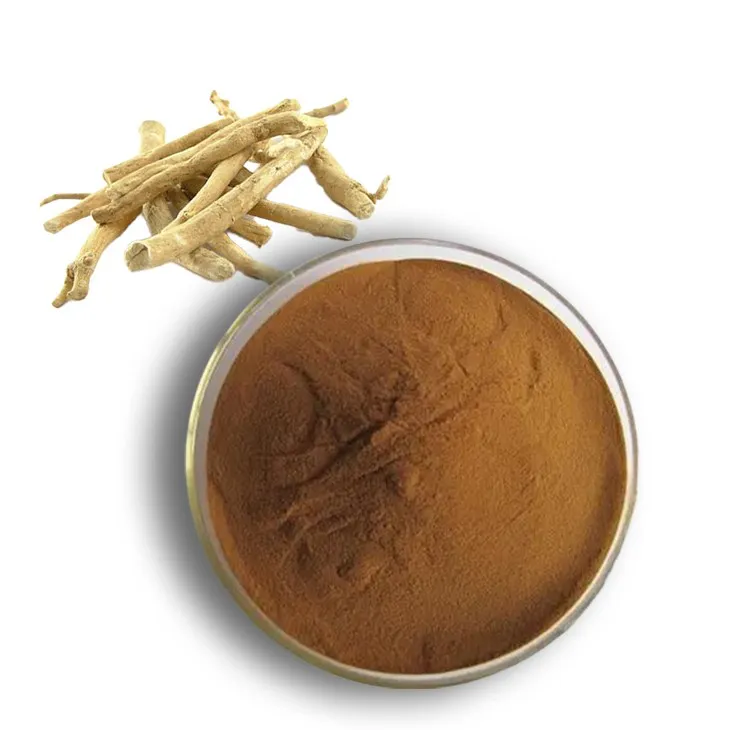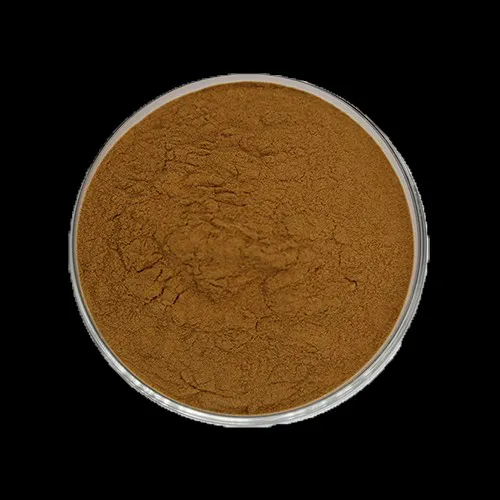- 0086-571-85302990
- sales@greenskybio.com
The process of extracting withanolides from Withania somnifera extract.
2024-11-30

1. Introduction
Withania somnifera, commonly known as Ashwagandha, has been used in traditional medicine for centuries. Withanolides, the bioactive compounds present in its extract, have attracted significant attention in various fields such as medicine, pharmaceuticals, and health - care products. These compounds possess a wide range of biological activities including anti - inflammatory, antioxidant, anti - cancer, and immunomodulatory properties. Therefore, the efficient extraction of withanolides from Withania Somnifera Extract is crucial for maximizing their potential applications.

2. Pretreatment of Withania somnifera Materials
2.1 Drying
The first step in the pretreatment process is drying the Withania somnifera plant materials. Drying helps to reduce the moisture content, which in turn prevents the growth of microorganisms and enzymatic degradation. Air - drying and oven - drying are two common methods. Air - drying is a more natural process, but it may take longer. Oven - drying, on the other hand, can be done at a controlled temperature and humidity, which can ensure a more consistent drying result. However, care must be taken not to expose the materials to excessive heat, as this may lead to the degradation of withanolides.
2.2 Grinding
After drying, the plant materials need to be ground into a fine powder. Grinding increases the surface area of the materials, which enhances the extraction efficiency. A mortar and pestle can be used for small - scale grinding, while for large - scale operations, mechanical grinders are more suitable. The particle size of the powder should be as uniform as possible. A finer powder generally results in better extraction, but if the powder is too fine, it may cause problems such as clogging during the extraction process.
3. Choice of Extraction Solvents
3.1 Polarity Considerations
The choice of extraction solvent is a crucial factor in the extraction of withanolides. Polarity plays a significant role in determining the solubility of withanolides. Withanolides are relatively non - polar compounds, so solvents with a certain degree of non - polarity are preferred. Ethanol is a commonly used solvent as it has a suitable polarity. It can dissolve withanolides effectively while also being relatively safe and easy to handle. Another option is methanol, which is more polar than ethanol but still can be used for extraction. However, methanol is more toxic and requires more careful handling.
3.2 Solubility Factors
In addition to polarity, the solubility of withanolides in different solvents also depends on other factors. For example, the presence of certain functional groups in the withanolide structure may affect its solubility. Some withanolides may have better solubility in solvents that can form specific interactions with these functional groups. Hexane, a non - polar solvent, can also be used in some cases, especially for the extraction of more hydrophobic withanolides. However, it may not be as effective for extracting all types of withanolides as it may not be able to dissolve some of the more polar components associated with withanolides in the plant extract.
3.3 Solvent Mixtures
In many cases, using a solvent mixture can be more advantageous than a single solvent. For example, a mixture of ethanol and water can be used. The addition of water can modify the polarity of the solvent system, which may be beneficial for extracting different types of withanolides. A certain ratio of ethanol to water, such as 70:30 (ethanol: water), has been found to be effective in some studies. This mixture can dissolve a wider range of withanolide compounds compared to pure ethanol or water alone. Another example is the use of chloroform - methanol mixtures for extraction, which can be particularly useful for the extraction of some complex withanolide derivatives.
4. Optimization of Extraction Conditions
4.1 Temperature
Temperature has a significant impact on the extraction efficiency of withanolides. Generally, an increase in temperature can enhance the solubility of withanolides in the solvent, thus increasing the extraction yield. However, too high a temperature may lead to the degradation of withanolides. For example, in the case of ethanol extraction, a temperature range of 40 - 60°C has been found to be optimal in many studies. At this temperature range, the withanolides can be effectively extracted without significant degradation. Different solvents may have different optimal temperature ranges depending on their properties and the stability of the withanolides in them.
4.2 Pressure
Pressure can also influence the extraction process. In some extraction methods such as supercritical fluid extraction, pressure is a critical parameter. Supercritical carbon dioxide (scCO₂) extraction is an emerging technique for withanolide extraction. By adjusting the pressure, the density and solubility of scCO₂ can be changed. At a certain pressure range, scCO₂ can effectively extract withanolides. For example, a pressure range of 10 - 30 MPa has been reported to be suitable for withanolide extraction using scCO₂. Higher pressure can increase the extraction efficiency, but it also requires more complex equipment and higher energy consumption.
4.3 Time
The extraction time is another important factor. Longer extraction times generally lead to higher extraction yields up to a certain point. However, after a certain time, the extraction rate may slow down, and further prolonging the extraction time may not significantly increase the yield. Moreover, longer extraction times may also increase the risk of withanolide degradation. For example, in a traditional solvent extraction using ethanol, an extraction time of 2 - 4 hours has been shown to be sufficient in many cases. The optimal extraction time needs to be determined based on the extraction method, solvent, and plant material characteristics.
5. Post - extraction Handling for Obtaining Pure Withanolides
5.1 Filtration
After the extraction process, the first step in post - extraction handling is filtration. Filtration is used to remove the solid residues such as plant debris from the extract. This can be done using a simple filter paper or a more advanced filtration system such as a Buchner funnel with a vacuum pump. Filtration helps to obtain a clear extract, which is a prerequisite for further purification steps.
5.2 Concentration
The next step is concentration of the extract. This can be achieved by methods such as rotary evaporation. Rotary evaporation is a common technique used to remove the solvent from the extract under reduced pressure. By concentrating the extract, the volume is reduced, and the concentration of withanolides in the remaining solution is increased. This is beneficial for subsequent purification steps as it reduces the amount of material to be processed further.
5.3 Purification
Purification is the key step to obtain pure withanolides. Chromatographic techniques are commonly used for this purpose. Column chromatography is a widely used method. In column chromatography, the extract is loaded onto a column filled with a stationary phase, such as silica gel or alumina. Different withanolides can be separated based on their different affinities for the stationary and mobile phases. High - performance liquid chromatography (HPLC) is another powerful purification technique. HPLC can provide high - resolution separation of withanolides, and it can be used to purify individual withanolide compounds with high purity.
5.4 Identification and Quantification
After purification, it is necessary to identify and quantify the withanolides. Spectroscopic techniques such as ultraviolet - visible (UV - Vis) spectroscopy, infrared (IR) spectroscopy, and nuclear magnetic resonance (NMR) spectroscopy can be used for identification. These techniques can provide information about the chemical structure of the withanolides. For quantification, methods such as HPLC with a suitable detector, such as a UV detector, can be used. This allows for the accurate determination of the amount of withanolides present in the purified sample, which is important for quality control in various applications.6. Conclusion
The extraction of withanolides from Withania Somnifera Extract is a complex process that involves multiple steps, from the pretreatment of plant materials to the post - extraction handling for obtaining pure withanolides. Each step, including the choice of extraction solvents, optimization of extraction conditions, and purification methods, plays a crucial role in determining the extraction efficiency and the quality of the final product. By carefully considering and optimizing these factors, it is possible to efficiently extract and purify withanolides, which can then be used in various fields such as medicine, pharmaceuticals, and health - care products to fully realize their potential biological activities.
FAQ:
What are the main pretreatment methods for Withania somnifera materials before extracting withanolides?
Pretreatment of Withania somnifera materials may include drying, grinding, and sieving. Drying helps to remove moisture, which can affect the extraction process. Grinding the dried material into a fine powder increases the surface area available for extraction, and sieving ensures a uniform particle size for better extraction efficiency.
How does the polarity of extraction solvents influence the extraction of withanolides?
The polarity of extraction solvents is crucial. Withanolides have specific solubility characteristics. Solvents with appropriate polarity can better dissolve withanolides. Polar solvents are often more effective in extracting polar components of withanolides, while non - polar solvents may be suitable for non - polar parts. The right choice of solvent polarity can enhance the extraction yield.
What are the typical extraction solvents used for withanolides extraction?
Common extraction solvents for withanolides include ethanol, methanol, and chloroform. Ethanol is often preferred due to its relatively high solubility for withanolides, its safety, and its availability. Methanol also has good extraction capabilities, but it is more toxic. Chloroform can be used in some cases, especially for extracting certain lipophilic components of withanolides.
How do temperature and time affect the extraction of withanolides?
Temperature can significantly influence the extraction. Higher temperatures generally increase the solubility of withanolides and the rate of extraction, but excessive heat may also cause degradation of the bioactive compounds. Regarding time, longer extraction times can increase the yield up to a certain point. However, after a certain duration, the extraction may reach equilibrium, and further increasing time may not significantly improve the yield.
What are the important steps in post - extraction handling for obtaining pure withanolides?
Post - extraction handling may involve steps such as filtration to remove solid impurities, evaporation to concentrate the extract, and purification techniques like chromatography. Filtration separates large particles from the extract. Evaporation reduces the volume of the solvent, making it easier to isolate withanolides. Chromatography, such as high - performance liquid chromatography (HPLC), can be used to separate and purify withanolides from other components in the extract.
Related literature
- Optimization of Withanolides Extraction from Withania somnifera: A Review"
- "Advanced Techniques in the Extraction of Withanolides from Withania Somnifera Extract"
- "Solvent Selection for Efficient Withanolide Extraction from Withania somnifera"
- ▶ Hesperidin
- ▶ Citrus Bioflavonoids
- ▶ Plant Extract
- ▶ lycopene
- ▶ Diosmin
- ▶ Grape seed extract
- ▶ Sea buckthorn Juice Powder
- ▶ Fruit Juice Powder
- ▶ Hops Extract
- ▶ Artichoke Extract
- ▶ Mushroom extract
- ▶ Astaxanthin
- ▶ Green Tea Extract
- ▶ Curcumin
- ▶ Horse Chestnut Extract
- ▶ Other Product
- ▶ Boswellia Serrata Extract
- ▶ Resveratrol
- ▶ Marigold Extract
- ▶ Grape Leaf Extract
- ▶ New Product
- ▶ Aminolevulinic acid
- ▶ Cranberry Extract
- ▶ Red Yeast Rice
- ▶ Red Wine Extract
-
Peppermint Oil
2024-11-30
-
Pine bark Extract Powder
2024-11-30
-
Bitter Melon Extract
2024-11-30
-
Saffron Extract Powder
2024-11-30
-
Sugarcane Extract
2024-11-30
-
Apricot Powder
2024-11-30
-
Lemon Balm Extract
2024-11-30
-
White Peony Extract
2024-11-30
-
Lycopene
2024-11-30
-
Green coffee bean Extract
2024-11-30





















